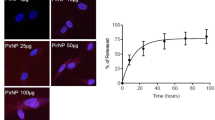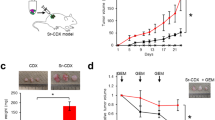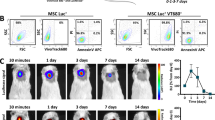Abstract
Human adipose tissue mesenchymal stromal cells (AMSCs) share common traits, including similar differentiation potential and cell surface markers, with their bone marrow counterparts. Owing to their general availability, higher abundance and ease of isolation AMSCs may be convenient autologous delivery vehicles for localized tumor therapy. We demonstrate a model for tumor therapy development based on the use of AMSCs expressing renilla luciferase and thymidine kinase, as cellular vehicles for ganciclovir-mediated bystander killing of firefly luciferase expressing tumors, and noninvasive bioluminescence imaging to continuously monitor both, tumor cells and AMSCs. We show that the therapy delivering AMSCs survive long time within tumors, optimize the ratio of AMSCs to tumor cells for therapy, and asses the therapeutic effect in real time. Treatment of mice bearing prostate tumors plus therapeutic AMSCs with the prodrug ganciclovir induced bystander killing effect, reducing the number of tumor cells to 1.5 % that of control tumors. Thus, AMSCs could be useful vehicles to deliver localized therapy, with potential for clinical application in inoperable tumors and surgical borders after tumor resection. This approach, useful to evaluate efficiency of therapeutic models, should facilitate the selection of cell types, dosages, therapeutic agents and treatment protocols for cell-based therapies of specific tumors.
This is a preview of subscription content, access via your institution
Access options
Subscribe to this journal
Receive 12 print issues and online access
$259.00 per year
only $21.58 per issue
Buy this article
- Purchase on Springer Link
- Instant access to full article PDF
Prices may be subject to local taxes which are calculated during checkout






Similar content being viewed by others
References
Portsmouth D, Hlavaty J, Renner M . Suicide genes for cancer therapy. Mol Aspects Med 2007; 28: 4–41.
Mesnil M, Piccoli C, Tiraby G, Willecke K, Yamasaki H . Bystander killing of cancer cells by herpes simplex virus thymidine kinase gene is mediated by connexins. Proc Natl Acad Sci USA 1996; 93: 1831–1835.
Freeman SM, Abboud CN, Whartenby KA, Packman CH, Koeplin DS, Moolten FL et al. The ‘bystander effect’: tumor regression when a fraction of the tumor mass is genetically modified. Cancer Res 1993; 53: 5274–5283.
Ramesh R, Marrogi AJ, Munshi A, Abboud CN, Freeman SM . In vivo analysis of the ‘bystander effect’: a cytokine cascade. Exp Hematol 1996; 24: 829–838.
Noble S, Faulds D . Ganciclovir. An update of its use in the prevention of cytomegalovirus infection and disease in transplant recipients. Drugs 1998; 56: 115–146.
Ray P, De A, Min JJ, Tsien RY, Gambhir SS . Imaging tri-fusion multimodality reporter gene expression in living subjects. Cancer Res 2004; 64: 1323–1330.
Cao F, Lin S, Xie X, Ray P, Patel M, Zhang X et al. In vivo visualization of embryonic stem cell survival, proliferation, and migration after cardiac delivery. Circulation 2006; 113: 1005–1014.
Elion GB, Furman PA, Fyfe JA, de Miranda P, Beauchamp L, Schaeffer HJ . Selectivity of action of an antiherpetic agent, 9-(2-hydroxyethoxymethyl) guanine. Proc Natl Acad Sci USA 1977; 74: 5716–5720.
Singhal S, Kaiser LR . Cancer chemotherapy using suicide genes. Surg Oncol Clin N Am 1998; 7: 505–536.
Rainov NG . A phase III clinical evaluation of herpes simplex virus type 1 thymidine kinase and ganciclovir gene therapy as an adjuvant to surgical resection and radiation in adults with previously untreated glioblastoma multiforme. Hum Gene Ther 2000; 11: 2389–2401.
Trask TW, Trask RP, Aguilar-Cordova E, Shine HD, Wyde PR, Goodman JC et al. Phase I study of adenoviral delivery of the HSV-tk gene and ganciclovir administration in patients with current malignant brain tumors. Mol Ther 2000; 1: 195–203.
Nanda D, Vogels R, Havenga M, Avezaat CJ, Bout A, Smitt PS . Treatment of malignant gliomas with a replicating adenoviral vector expressing herpes simplex virus-thymidine kinase. Cancer Res 2001; 61: 8743–8750.
Gadal F, Bastias J, Wei MX, Crepin M . ‘Suicide’ gene therapy of breast cancer cells is only cytostatic in vitro but anti-tumoral in vivo on breast MCF7-ras tumor. In Vivo 2004; 18: 813–818.
Ram Z, Culver KW, Walbridge S, Blaese RM, Oldfield EH . In situ retroviral-mediated gene transfer for the treatment of brain tumors in rats. Cancer Res 1993; 53: 83–88.
Culver KW, Ram Z, Wallbridge S, Ishii H, Oldfield EH, Blaese RM . In vivo gene transfer with retroviral vector-producer cells for treatment of experimental brain tumors. Science 1992; 256: 1550–1552.
Barba D, Hardin J, Ray J, Gage FH . Thymidine kinase-mediated killing of rat brain tumors. J Neurosurg 1993; 79: 729–735.
Moolten FL . Tumor chemosensitivity conferred by inserted herpes thymidine kinase genes: paradigm for a prospective cancer control strategy. Cancer Res 1986; 46: 5276–5281.
Burton EA, Fink DJ, Glorioso JC . Gene delivery using herpes simplex virus vectors. DNA Cell Biol 2002; 21: 915–936.
Pasanen T, Hakkarainen T, Timonen P, Parkkinen J, Tenhunen A, Loimas S et al. TK-GFP fusion gene virus vectors as tools for studying the features of HSV-TK/ganciclovir cancer gene therapy in vivo. Int J Mol Med 2003; 12: 525–531.
Miletic H, Fischer YH, Giroglou T, Rueger MA, Winkeler A, Li H et al. Normal brain cells contribute to the bystander effect in suicide gene therapy of malignant glioma. Clin Cancer Res 2007; 13: 6761–6768.
Galipeau J, Li H, Paquin A, Sicilia F, Karpati G, Nalbantoglu J . Vesicular stomatitis virus G pseudotyped retrovector mediates effective in vivo suicide gene delivery in experimental brain cancer. Cancer Res 1999; 59: 2384–2394.
Satoh T, Irie A, Egawa S, Baba S . In situ gene therapy for prostate cancer. Curr Gene Ther 2005; 5: 111–119.
Xing Y, Xiao Y, Lu G, Zeng F, Zhao J, Xiong P et al. Cooperative therapeutic effects of herpes simplex virus thymidine kinase gene/ganciclovir system and chemotherapeutic agents on prostate cancer in vitro. J Huazhong Univ Sci Technol Med Sci 2006; 26: 610–613.
Ferrer FA, Rodriguez R . Prostate cancer gene therapy. Hematol Oncol Clin North Am 2001; 15: 497–508.
Blackburn RV, Galoforo SS, Corry PM, Lee YJ . Adenoviral-mediated transfer of a heat-inducible double suicide gene into prostate carcinoma cells. Cancer Res 1998; 58: 1358–1362.
Loimas S, Toppinen MR, Visakorpi T, Janne J, Wahlfors J . Human prostate carcinoma cells as targets for herpes simplex virus thymidine kinase-mediated suicide gene therapy. Cancer Gene Ther 2001; 8: 137–144.
Studeny M, Marini FC, Dembinski JL, Zompetta C, Cabreira-Hansen M, Bekele BN et al. Mesenchymal stem cells: potential precursors for tumor stroma and targeted-delivery vehicles for anticancer agents. J Natl Cancer Inst 2004; 96: 1593–1603.
Studeny M, Marini FC, Champlin RE, Zompetta C, Fidler IJ, Andreeff M . Bone marrow-derived mesenchymal stem cells as vehicles for interferon-beta delivery into tumors. Cancer Res 2002; 62: 3603–3608.
Hamada H, Kobune M, Nakamura K, Kawano Y, Kato K, Honmou O et al. Mesenchymal stem cells (MSC) as therapeutic cytoreagents for gene therapy. Cancer Sci 2005; 96: 149–156.
Nakamura K, Ito Y, Kawano Y, Kurozumi K, Kobune M, Tsuda H et al. Antitumor effect of genetically engineered mesenchymal stem cells in a rat glioma model. Gene Ther 2004; 11: 1155–1164.
Xin H, Kanehira M, Mizuguchi H, Hayakawa T, Kikuchi T, Nukiwa T et al. Targeted delivery of CX3CL1 to multiple lung tumors by mesenchymal stem cells. Stem Cells 2007; 25: 1618–1626.
Nakamizo A, Marini F, Amano T, Khan A, Studeny M, Gumin J et al. Human bone marrow-derived mesenchymal stem cells in the treatment of gliomas. Cancer Res 2005; 65: 3307–3318.
Komarova S, Kawakami Y, Stoff-Khalili MA, Curiel DT, Pereboeva L . Mesenchymal progenitor cells as cellular vehicles for delivery of oncolytic adenoviruses. Mol Cancer Ther 2006; 5: 755–766.
Hung SC, Deng WP, Yang WK, Liu RS, Lee CC, Su TC et al. Mesenchymal stem cell targeting of microscopic tumors and tumor stroma development monitored by noninvasive in vivo positron emission tomography imaging. Clin Cancer Res 2005; 11: 7749–7756.
Lazennec G, Jorgensen C . Concise review: adult multipotent stromal cells and cancer: risk or benefit? Stem Cells 2008; 26: 1387–1394.
Zuk PA, Zhu M, Ashjian P, De Ugarte DA, Huang JI, Mizuno H et al. Human adipose tissue is a source of multipotent stem cells. Mol Biol Cell 2002; 13: 4279–4295.
Zuk PA, Zhu M, Mizuno H, Huang J, Futrell JW, Katz AJ et al. Multilineage cells from human adipose tissue: implications for cell-based therapies. Tissue Eng 2001; 7: 211–228.
Kern S, Eichler H, Stoeve J, Kluter H, Bieback K . Comparative analysis of mesenchymal stem cells from bone marrow, umbilical cord blood, or adipose tissue. Stem Cells 2006; 24: 1294–1301.
Wagner W, Wein F, Seckinger A, Frankhauser M, Wirkner U, Krause U et al. Comparative characteristics of mesenchymal stem cells from human bone marrow, adipose tissue, and umbilical cord blood. Exp Hematol 2005; 33: 1402–1416.
Kucerova L, Altanerova V, Matuskova M, Tyciakova S, Altaner C . Adipose tissue-derived human mesenchymal stem cells mediated prodrug cancer gene therapy. Cancer Res 2007; 67: 6304–6313.
Pereboeva L, Komarova S, Mikheeva G, Krasnykh V, Curiel DT . Approaches to utilize mesenchymal progenitor cells as cellular vehicles. Stem Cells 2003; 21: 389–404.
Miletic H, Fischer Y, Litwak S, Giroglou T, Waerzeggers Y, Winkeler A et al. Bystander killing of malignant glioma by bone marrow-derived tumor-infiltrating progenitor cells expressing a suicide gene. Mol Ther 2007; 15: 1373–1381.
Fareed MU, Moolten FL . Suicide gene transduction sensitizes murine embryonic and human mesenchymal stem cells to ablation on demand—a fail-safe protection against cellular misbehavior. Gene Ther 2002; 9: 955–962.
Vilalta M, Dégano IR, Bagó JR, Gould D, Santos M, García-Arranz M et al. Biodistribution, long term survival and safety of human adipose tissue derived mesenchymal stem cells transplanted in nude mice by high sensitivity non-invasive bioluminescence imaging. Stem Cells and Dev 2008; 17: 993–1003.
Hall B, Dembinski J, Sasser AK, Studeny M, Andreeff M, Marini F . Mesenchymal stem cells in cancer: tumor-associated fibroblasts and cell-based delivery vehicles. Int J Hematol 2007; 86: 8–16.
Hall B, Andreeff M, Marini F . The participation of mesenchymal stem cells in tumor stroma formation and their application as targeted-gene delivery vehicles. Handb Exp Pharmacol 2007; 180: 263–283.
Wu XZ, Chen D, Xie GR . Bone marrow-derived cells: roles in solid tumor. Minireview. Neoplasma 2007; 54: 1–6.
Rubio N, Villacampa MM, El Hilali N, Blanco J . Metastatic burden in nude mice organs measured using prostate tumor PC-3 cells expressing the luciferase gene as a quantifiable tumor cell marker. Prostate 2000; 44: 133–143.
Carroll NM, Chase M, Chiocca EA, Tanabe KK . The effect of ganciclovir on herpes simplex virus-mediated oncolysis. J Surg Res 1997; 69: 413–417.
Marconi P, Tamura M, Moriuchi S, Krisky DM, Niranjan A, Goins WF et al. Connexin 43-enhanced suicide gene therapy using herpesviral vectors. Mol Ther 2000; 1: 71–81.
Acknowledgements
This study was funded in part by grants from Fundació Marató TV3 (Ref no. 050210), Fondo de Investigación Sanitaria (FIS, PI 060208), Ministerio de Educación y Ciencia (SAF 2007-62472), Red Temática de Investigación Cooperativa TERCEL.
Author information
Authors and Affiliations
Corresponding author
Additional information
Supplementary Information accompanies the paper on Gene Therapy website (http://www.nature.com/gt)
Supplementary information
Rights and permissions
About this article
Cite this article
Vilalta, M., Dégano, I., Bagó, J. et al. Human adipose tissue-derived mesenchymal stromal cells as vehicles for tumor bystander effect: a model based on bioluminescence imaging. Gene Ther 16, 547–557 (2009). https://doi.org/10.1038/gt.2008.176
Received:
Revised:
Accepted:
Published:
Issue Date:
DOI: https://doi.org/10.1038/gt.2008.176



